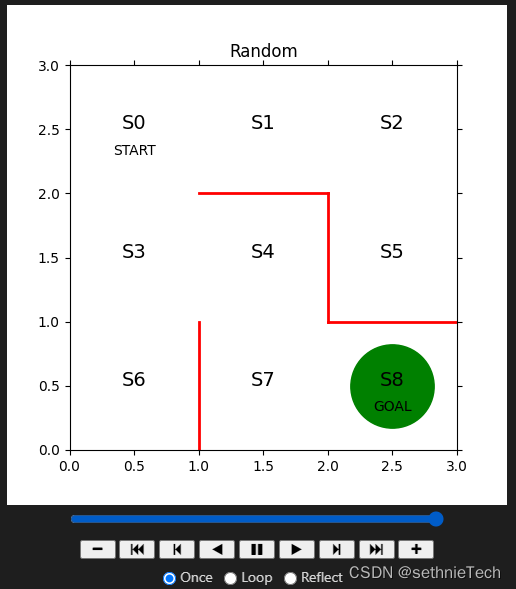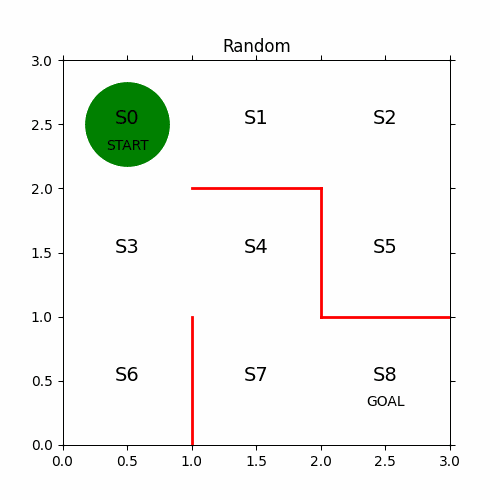迷宫_随机实验_边做边学深度强化学习:PyTorch程序设计实践
0、相关文章
迷宫_Sarsa算法_边做边学深度强化学习:PyTorch程序设计实践(2)
1、导入所使用的包
# 导入所使用的包
import numpy as np
import matplotlib.pyplot as plt
2、 定义迷宫
fig = plt.figure(figsize=(5, 5))
ax = plt.gca()
# 画出红色的墙壁
plt.plot([1, 1], [0, 1], color='red', linewidth=2)
plt.plot([1, 2], [2, 2], color='red', linewidth=2)
plt.plot([2, 2], [2, 1], color='red', linewidth=2)
plt.plot([2, 3], [1, 1], color='red', linewidth=2)
# 画出表示状态的文字S0-S8
plt.text(0.5, 2.5, 'S0', size=14, ha='center')
plt.text(1.5, 2.5, 'S1', size=14, ha='center')
plt.text(2.5, 2.5, 'S2', size=14, ha='center')
plt.text(0.5, 1.5, 'S3', size=14, ha='center')
plt.text(1.5, 1.5, 'S4', size=14, ha='center')
plt.text(2.5, 1.5, 'S5', size=14, ha='center')
plt.text(0.5, 0.5, 'S6', size=14, ha='center')
plt.text(1.5, 0.5, 'S7', size=14, ha='center')
plt.text(2.5, 0.5, 'S8', size=14, ha='center')
plt.text(0.5, 2.3, 'START', ha='center')
plt.text(2.5, 0.3, 'GOAL', ha='center')
# 设定画图的范围
ax.set_xlim(0, 3)
ax.set_ylim(0, 3)
ax.set_title("Random")
plt.tick_params(axis='both', which='both', bottom='off', top='off',
labelbottom='off', right='off', left='off', labelleft='off')
# 当前位置S0用绿色圆圈画出
line, = ax.plot([0.5], [2.5], marker="o", color='g', markersize=60)
3、定义迷宫动作
# 设定参数θ的初始值theta_0,用于确定初始方案
# 行为状态0~7,列为用↑、→、↓、←表示的移动方向
theta_0 = np.array([[np.nan, 1, 1, np.nan], # s0
[np.nan, 1, np.nan, 1], # s1
[np.nan, np.nan, 1, 1], # s2
[1, 1, 1, np.nan], # s3
[np.nan, np.nan, 1, 1], # s4
[1, np.nan, np.nan, np.nan], # s5
[1, np.nan, np.nan, np.nan], # s6
[1, 1, np.nan, np.nan], # s7、※s8是目标,无策略
])
效果:
4、策略参数θ转换为行动策略π
def simple_convert_into_pi_from_theta(theta):
'''简单计算百分比'''
[m, n] = theta.shape # 获取theta矩阵大小
pi = np.zeros((m, n))
for i in range(0, m):
pi[i, :] = theta[i, :] / np.nansum(theta[i, :]) # 计算百分比
pi = np.nan_to_num(pi) # 将nan转换为0
return pi
5、定义随机移动函数
# 1步移动后求得状态s
def get_next_s(pi, s):
direction = ["up", "right", "down", "left"]
# 根据概率pi[s,:]选择direction
next_direction = np.random.choice(direction, p=pi[s, :])
# 移动后切换状态
if next_direction == "up":
s_next = s - 3
elif next_direction == "right":
s_next = s + 1
elif next_direction == "down":
s_next = s + 3
elif next_direction == "left":
s_next = s - 1
return s_next
6、定义使智能体移动到目标的函数
def goal_maze(pi):
s = 0 # 开始地点
state_history = [0] # 记录智能体移动轨迹的列表
while (1): # 循环,直至到达目标
next_s = get_next_s(pi, s)
state_history.append(next_s)
if next_s == 8: # 到达目标地点则终止
for i in range(0,10):
state_history.append(next_s)
break
else:
s = next_s
return state_history
7、智能体移动到目标
# 求初始策略π
pi_0 = simple_convert_into_pi_from_theta(theta_0)
state_history = goal_maze(pi_0)
print(state_history)
print("求解迷宫问题所需要的步数是:" + str(len(state_history) - 1))
8、运行路径可视化
# 参考URL http://louistiao.me/posts/notebooks/embedding-matplotlib-animations-in-jupyter-notebooks/
from matplotlib import animation
from IPython.display import HTML
def init():
'''初始化背景图像'''
line.set_data([], [])
return (line,)
def animate(i):
'''每一帧的画面内容'''
state = state_history[i] # 画出当前的位置
x = (state % 3) + 0.5 # 状态的x坐标为状态数除以3的余数加0.5
y = 2.5 - int(state / 3) # 状态y坐标为2.5减去状态数除以3的商
line.set_data(x, y)
return (line,)
# 用初始化函数和绘图函数来生成动画
anim = animation.FuncAnimation(fig, animate, init_func=init, frames=len(
state_history), interval=200, repeat=False)
anim.save('result/maze_Random.gif',writer='pillow')
HTML(anim.to_jshtml())
9、最终结果


10、代码下载
10、参考资料
版权声明:本文为qq_34206137原创文章,遵循CC 4.0 BY-SA版权协议,转载请附上原文出处链接和本声明。